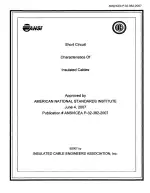ICEA P-32-382:2007 PDF Download
Standard EN SampleShort Circuit Characteristics of Insulated Cable
Also Known As:
SKU111967931
Published by
Insulated Cable Engineers Association
ICEA
Publication Date2007
Pages CountPages22
Equations have been established for short circuit calculations
for conductors made of copper or aluminum. The coverings and
insulations, which determine the maximum allowable short circuit
temperatures, are paper, varnished cloth and several thermoplastic
and thermosetting materials presently appearing in ICEA standards.
Temperature limits, considered safe, were established for the
various covering and insulation materials.
The equations may be used to determine:
• The maximum short circuit permitted for a specific conductor and short circuit duration.
• The conductor size necessary to carry a specific short circuit current for a given duration.
• The maximum duration a specific conductor can carry a specific short circuit current.
A formula has been established for short circuit calculations with conductors of copper or aluminum. The insulations, which determine the maximum allowed short circuit temperatures, are described in the ICEA Standards. The formula is based on the heat content of the conductor material and the temperature limit of the insulation with the assumption that the time interval is so short that the heat developed during the short circuit is contained in the conductor. At the time this document was originally published there was no standard mathematical method available to calculate heat flow from the conductor through the insulation at the cessation of the short circuit load. It was necessary to enlist the aid and facilities of member laboratories and Massachusetts Institute of Technology to obtain in cooperation a solution to this problem so that safe temperature limits could be established for the various types of insulations. The solution is still a viable, conservative approach to the calculation of short circuit capacity.
Results are sufficiently conservative to neglect conductor skin-effect except for very large conductors. Skin-effect can be taken into account by dividing the right-hand member of the equations shown by the appropriate conductor ac/dc resistance ratio.
The equations may be used to determine:
• The maximum short circuit permitted for a specific conductor and short circuit duration.
• The conductor size necessary to carry a specific short circuit current for a given duration.
• The maximum duration a specific conductor can carry a specific short circuit current.
A formula has been established for short circuit calculations with conductors of copper or aluminum. The insulations, which determine the maximum allowed short circuit temperatures, are described in the ICEA Standards. The formula is based on the heat content of the conductor material and the temperature limit of the insulation with the assumption that the time interval is so short that the heat developed during the short circuit is contained in the conductor. At the time this document was originally published there was no standard mathematical method available to calculate heat flow from the conductor through the insulation at the cessation of the short circuit load. It was necessary to enlist the aid and facilities of member laboratories and Massachusetts Institute of Technology to obtain in cooperation a solution to this problem so that safe temperature limits could be established for the various types of insulations. The solution is still a viable, conservative approach to the calculation of short circuit capacity.
Results are sufficiently conservative to neglect conductor skin-effect except for very large conductors. Skin-effect can be taken into account by dividing the right-hand member of the equations shown by the appropriate conductor ac/dc resistance ratio.
Details
History and complementary documents
History
| Language(s) | English |
| File Size | 501.8 KB |
Purchase
Right after completing the purchase process, you will immediately get a digital copy of this standard which is:
Not Locked
Printable
Multi-User
$
9.00


